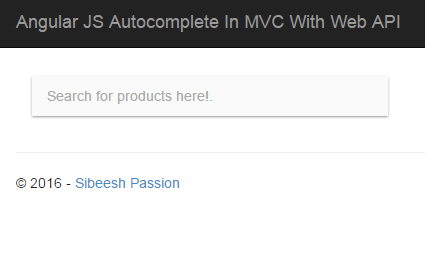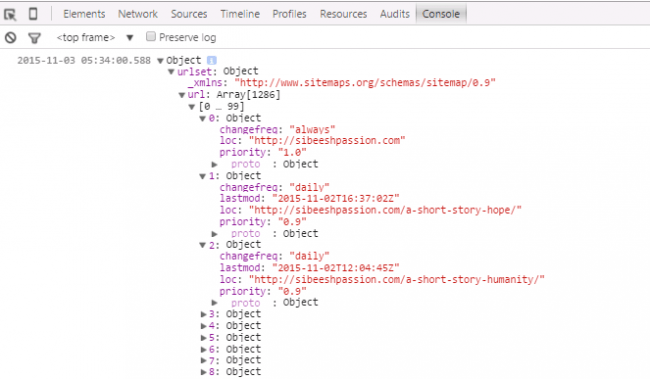jQuery Datatable With Server Side Data
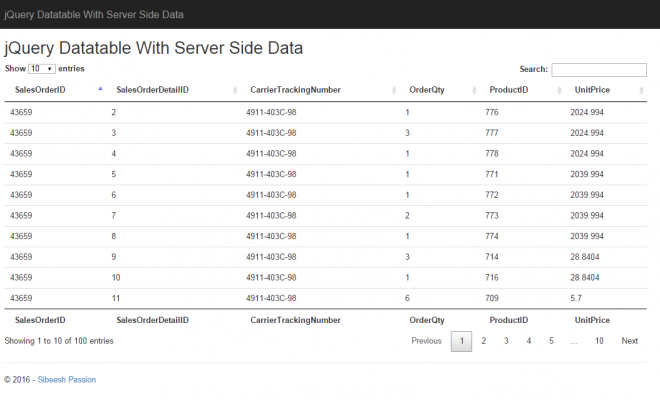
Introduction
In this article, we will learn how we can work with jQuery Datatables with server-side data. Here we are going to use an MVC application with jQuery and other required packages installed in it. If you are new to MVC, You can always get the tips/tricks/blogs about that here MVC Tips, Tricks, Blogs. jQuery Datatables is a client-side grid control that is lightweight and easy to use. But when it comes to grid control, it must be usable when it supports the server-side loading of data. This control is perfect for that. I guess, it is enough for the introduction. Now we will start using our grid. I hope you will like this.
Download the source code
You can always download the source code here:
Create a MVC application
Click File-> New-> Project then select MVC application. Before going to start the coding part, make sure that all the required extensions/references are installed. Below are the required things to start with.
- Datatables Package
- jQuery
You can all the items mentioned above from NuGet. Right-click on your project name and select Manage NuGet packages.
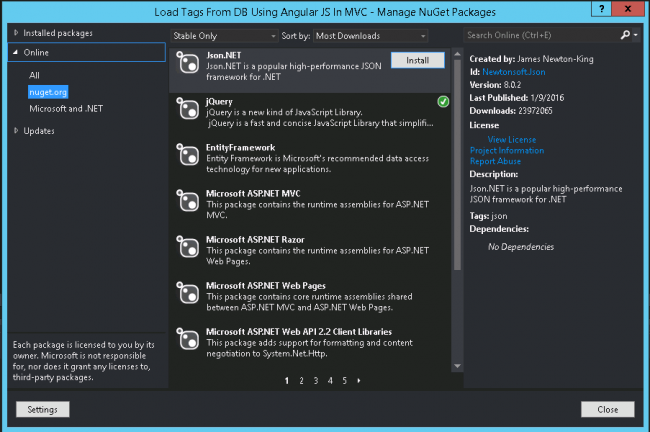
Once you have installed those items, please make sure that all the items(jQuery, Datatables JS files) are loaded in your scripts folder.
Using the code
Now let us add the needed references.
Include the references in your _Layout.cshtml
As we have already installed all the packages we need, now we need to add the references, right? After adding the reference, your _Layout.cshtml will looks like below.
| <!DOCTYPE html> | |
| <html> | |
| <head> | |
| <meta charset="utf-8" /> | |
| <meta name="viewport" content="width=device-width, initial-scale=1.0"> | |
| <title>@ViewBag.Title - My ASP.NET Application</title> | |
| <link href="~/Content/Site.css" rel="stylesheet" type="text/css" /> | |
| <link href="~/Content/bootstrap.min.css" rel="stylesheet" type="text/css" /> | |
| <link href="~/Content/DataTables/css/jquery.dataTables.min.css" rel="stylesheet" /> | |
| <script src="~/Scripts/modernizr-2.6.2.js"></script> | |
| <script src="~/scripts/jquery-2.2.0.min.js"></script> | |
| <script src="~/scripts/jquery-ui-1.10.2.min.js"></script> | |
| <script src="~/scripts/DataTables/jquery.dataTables.min.js"></script> | |
| <script src="~/scripts/MyScripts.js"></script> | |
| <script src="~/Scripts/bootstrap.min.js"></script> | |
| </head> | |
| <body> | |
| <div class="navbar navbar-inverse navbar-fixed-top"> | |
| <div class="container"> | |
| <div class="navbar-header"> | |
| <button type="button" class="navbar-toggle" data-toggle="collapse" data-target=".navbar-collapse"> | |
| <span class="icon-bar"></span> | |
| <span class="icon-bar"></span> | |
| <span class="icon-bar"></span> | |
| </button> | |
| @Html.ActionLink("jQuery Datatable With Server Side Data", "Index", "Home", new { area = "" }, new { @class = "navbar-brand" }) | |
| </div> | |
| <div class="navbar-collapse collapse"> | |
| <ul class="nav navbar-nav"> | |
| </ul> | |
| </div> | |
| </div> | |
| </div><div class="container body-content"> | |
| @RenderBody() | |
| <hr /> | |
| <footer> | |
| <p>© @DateTime.Now.Year - <a href="http://sibeeshpassion.com">Sibeesh Passion</a></p> | |
| </footer> | |
| </div> | |
| </body> | |
| </html> |
Here MyScripts.js is the JavaScript file where we are going to write our own scripts.
Add a normal MVC controller
Now we will add a normal MVC controller in our app. Once you add that you can see an ActionResult is created for us.
public ActionResult Index()
{
return View();
}
Right-click on the controller, and click add view, that will create a View for you. Now we will change the view as follows.
| @{ | |
| ViewBag.Title = "jQuery Datatable With Server Side Data"; | |
| } | |
| <h2>jQuery Datatable With Server Side Data</h2> | |
| <table id="myGrid" class="table"> | |
| <thead> | |
| <tr> | |
| <th>SalesOrderID</th> | |
| <th>SalesOrderDetailID</th> | |
| <th>CarrierTrackingNumber</th> | |
| <th>OrderQty</th> | |
| <th>ProductID</th> | |
| <th>UnitPrice</th> | |
| </tr> | |
| </thead> | |
| <tfoot> | |
| <tr> | |
| <th>SalesOrderID</th> | |
| <th>SalesOrderDetailID</th> | |
| <th>CarrierTrackingNumber</th> | |
| <th>OrderQty</th> | |
| <th>ProductID</th> | |
| <th>UnitPrice</th> | |
| </tr> | |
| </tfoot> | |
| </table> |
So we have set the headers and footer for our grid, where we are going to load the grid control in the table myGrid. So far the UI part is done, now it is time to set up our database and entity model. Are you ready?
Create a database
The following query can be used to create a database in your SQL Server.
| USE [master] | |
| GO | |
| /****** Object: Database [TrialsDB] Script Date: 17-Feb-16 10:21:17 PM ******/ | |
| CREATE DATABASE [TrialsDB] | |
| CONTAINMENT = NONE | |
| ON PRIMARY | |
| ( NAME = N'TrialsDB', FILENAME = N'C:\Program Files\Microsoft SQL Server\MSSQL11.MSSQLSERVER\MSSQL\DATA\TrialsDB.mdf' , SIZE = 3072KB , MAXSIZE = UNLIMITED, FILEGROWTH = 1024KB ) | |
| LOG ON | |
| ( NAME = N'TrialsDB_log', FILENAME = N'C:\Program Files\Microsoft SQL Server\MSSQL11.MSSQLSERVER\MSSQL\DATA\TrialsDB_log.ldf' , SIZE = 1024KB , MAXSIZE = 2048GB , FILEGROWTH = 10%) | |
| GO | |
| ALTER DATABASE [TrialsDB] SET COMPATIBILITY_LEVEL = 110 | |
| GO | |
| IF (1 = FULLTEXTSERVICEPROPERTY('IsFullTextInstalled')) | |
| begin | |
| EXEC [TrialsDB].[dbo].[sp_fulltext_database] @action = 'enable' | |
| end | |
| GO | |
| ALTER DATABASE [TrialsDB] SET ANSI_NULL_DEFAULT OFF | |
| GO | |
| ALTER DATABASE [TrialsDB] SET ANSI_NULLS OFF | |
| GO | |
| ALTER DATABASE [TrialsDB] SET ANSI_PADDING OFF | |
| GO | |
| ALTER DATABASE [TrialsDB] SET ANSI_WARNINGS OFF | |
| GO | |
| ALTER DATABASE [TrialsDB] SET ARITHABORT OFF | |
| GO | |
| ALTER DATABASE [TrialsDB] SET AUTO_CLOSE OFF | |
| GO | |
| ALTER DATABASE [TrialsDB] SET AUTO_CREATE_STATISTICS ON | |
| GO | |
| ALTER DATABASE [TrialsDB] SET AUTO_SHRINK OFF | |
| GO | |
| ALTER DATABASE [TrialsDB] SET AUTO_UPDATE_STATISTICS ON | |
| GO | |
| ALTER DATABASE [TrialsDB] SET CURSOR_CLOSE_ON_COMMIT OFF | |
| GO | |
| ALTER DATABASE [TrialsDB] SET CURSOR_DEFAULT GLOBAL | |
| GO | |
| ALTER DATABASE [TrialsDB] SET CONCAT_NULL_YIELDS_NULL OFF | |
| GO | |
| ALTER DATABASE [TrialsDB] SET NUMERIC_ROUNDABORT OFF | |
| GO | |
| ALTER DATABASE [TrialsDB] SET QUOTED_IDENTIFIER OFF | |
| GO | |
| ALTER DATABASE [TrialsDB] SET RECURSIVE_TRIGGERS OFF | |
| GO | |
| ALTER DATABASE [TrialsDB] SET DISABLE_BROKER | |
| GO | |
| ALTER DATABASE [TrialsDB] SET AUTO_UPDATE_STATISTICS_ASYNC OFF | |
| GO | |
| ALTER DATABASE [TrialsDB] SET DATE_CORRELATION_OPTIMIZATION OFF | |
| GO | |
| ALTER DATABASE [TrialsDB] SET TRUSTWORTHY OFF | |
| GO | |
| ALTER DATABASE [TrialsDB] SET ALLOW_SNAPSHOT_ISOLATION OFF | |
| GO | |
| ALTER DATABASE [TrialsDB] SET PARAMETERIZATION SIMPLE | |
| GO | |
| ALTER DATABASE [TrialsDB] SET READ_COMMITTED_SNAPSHOT OFF | |
| GO | |
| ALTER DATABASE [TrialsDB] SET HONOR_BROKER_PRIORITY OFF | |
| GO | |
| ALTER DATABASE [TrialsDB] SET RECOVERY FULL | |
| GO | |
| ALTER DATABASE [TrialsDB] SET MULTI_USER | |
| GO | |
| ALTER DATABASE [TrialsDB] SET PAGE_VERIFY CHECKSUM | |
| GO | |
| ALTER DATABASE [TrialsDB] SET DB_CHAINING OFF | |
| GO | |
| ALTER DATABASE [TrialsDB] SET FILESTREAM( NON_TRANSACTED_ACCESS = OFF ) | |
| GO | |
| ALTER DATABASE [TrialsDB] SET TARGET_RECOVERY_TIME = 0 SECONDS | |
| GO | |
| ALTER DATABASE [TrialsDB] SET READ_WRITE | |
| GO |
Now we will create a table 🙂
Create table in database
Below is the query to create table in database.
| USE [TrialsDB] | |
| GO | |
| /****** Object: Table [dbo].[SalesOrderDetail] Script Date: 19-Feb-16 12:30:55 PM ******/ | |
| SET ANSI_NULLS ON | |
| GO | |
| SET QUOTED_IDENTIFIER ON | |
| GO | |
| CREATE TABLE [dbo].[SalesOrderDetail]( | |
| [SalesOrderID] [int] NOT NULL, | |
| [SalesOrderDetailID] [int] IDENTITY(1,1) NOT NULL, | |
| [CarrierTrackingNumber] [nvarchar](25) NULL, | |
| [OrderQty] [smallint] NOT NULL, | |
| [ProductID] [int] NOT NULL, | |
| [SpecialOfferID] [int] NOT NULL, | |
| [UnitPrice] [money] NOT NULL, | |
| [UnitPriceDiscount] [money] NOT NULL, | |
| [LineTotal] AS (isnull(([UnitPrice]*((1.0)-[UnitPriceDiscount]))*[OrderQty],(0.0))), | |
| [rowguid] [uniqueidentifier] ROWGUIDCOL NOT NULL, | |
| [ModifiedDate] [datetime] NOT NULL, | |
| CONSTRAINT [PK_SalesOrderDetail_SalesOrderID_SalesOrderDetailID] PRIMARY KEY CLUSTERED | |
| ( | |
| [SalesOrderID] ASC, | |
| [SalesOrderDetailID] ASC | |
| )WITH (PAD_INDEX = OFF, STATISTICS_NORECOMPUTE = OFF, IGNORE_DUP_KEY = OFF, ALLOW_ROW_LOCKS = ON, ALLOW_PAGE_LOCKS = ON) ON [PRIMARY] | |
| ) ON [PRIMARY] | |
| GO |
Insert data to table
To insert the data, I will attach a database script file along with the download file, you can either run that or insert some data by using the below query. By the way, if you would like to know how to generate scripts with data in SQL Server, you can check here.
| USE [TrialsDB] | |
| GO | |
| INSERT INTO [dbo].[SalesOrderDetail] | |
| ([SalesOrderID] | |
| ,[CarrierTrackingNumber] | |
| ,[OrderQty] | |
| ,[ProductID] | |
| ,[SpecialOfferID] | |
| ,[UnitPrice] | |
| ,[UnitPriceDiscount] | |
| ,[rowguid] | |
| ,[ModifiedDate]) | |
| VALUES | |
| (<SalesOrderID, int,> | |
| ,<CarrierTrackingNumber, nvarchar(25),> | |
| ,<OrderQty, smallint,> | |
| ,<ProductID, int,> | |
| ,<SpecialOfferID, int,> | |
| ,<UnitPrice, money,> | |
| ,<UnitPriceDiscount, money,> | |
| ,<rowguid, uniqueidentifier,> | |
| ,<ModifiedDate, datetime,>) | |
| GO |
Along with this, we can create a new stored procedure that will fetch the data. Following is the query to create the stored procedure.
| USE [TrialsDB] | |
| GO | |
| /****** Object: StoredProcedure [dbo].[usp_Get_SalesOrderDetail] Script Date: 19-Feb-16 12:33:43 PM ******/ | |
| SET ANSI_NULLS ON | |
| GO | |
| SET QUOTED_IDENTIFIER ON | |
| GO | |
| -- ============================================= | |
| -- Author: <Author,Sibeesh Venu> | |
| -- Create date: <Create Date, 18-Feb-2016> | |
| -- Description: <Description,To fetch SalesOrderDetail> | |
| -- ============================================= | |
| ALTER PROCEDURE [dbo].[usp_Get_SalesOrderDetail] | |
| AS | |
| BEGIN | |
| -- SET NOCOUNT ON added to prevent extra result sets from | |
| -- interfering with SELECT statements. | |
| SET NOCOUNT ON; | |
| -- Select statements for procedure here | |
| SELECT top(100) SalesOrderID,SalesOrderDetailID,CarrierTrackingNumber,OrderQty,ProductID,UnitPrice,ModifiedDate from dbo.SalesOrderDetail | |
| END |
Next thing we are going to do is creating a ADO.NET Entity Data Model.
Create Entity Data Model
Right-click on your model folder and click new, select ADO.NET Entity Data Model. Follow the steps given. Once you have done the processes, you can see the edmx file and other files in your model folder.
Now we will go back to our controller and add a new JsonResult which can be called via a new jQuery Ajax request. No worries, we will create that Ajax requests later. Once you add the Jsonresult action, I hope your controller will look like this.
| using System; | |
| using System.Collections.Generic; | |
| using System.Linq; | |
| using System.Web; | |
| using System.Web.Mvc; | |
| using jQuery_Datatable_With_Server_Side_Data.Models; | |
| namespace jQuery_Datatable_With_Server_Side_Data.Controllers | |
| { | |
| public class HomeController: Controller | |
| { | |
| TrialsDBEntities tdb; | |
| Sales sa = new Sales(); | |
| public ActionResult Index() | |
| { | |
| return View(); | |
| } | |
| public JsonResult GetGata() | |
| { | |
| try | |
| { | |
| using(tdb = new TrialsDBEntities()) | |
| { | |
| var myList = sa.GetSales(tdb); | |
| return Json(myList, JsonRequestBehavior.AllowGet); | |
| } | |
| } | |
| catch (Exception) | |
| { | |
| throw; | |
| } | |
| } | |
| } | |
| } |
Here TrialsDBEntities is our entity class. Please be noted that to use the model classes in your controller, you must add the reference as follows.
using jQuery_Datatable_With_Server_Side_Data.Models;
I know all you are familiar with this, I am just saying!. Now can we create a function GetSales in our model class Sales ?.
| public object GetSales(TrialsDBEntities tdb) | |
| { | |
| try | |
| { | |
| var myList = ((from l in tdb.SalesOrderDetails select new | |
| { | |
| SalesOrderID = l.SalesOrderID, | |
| SalesOrderDetailID = l.SalesOrderDetailID, | |
| CarrierTrackingNumber = l.CarrierTrackingNumber, | |
| OrderQty = l.OrderQty, | |
| ProductID = l.ProductID, | |
| UnitPrice = l.UnitPrice | |
| }).OrderBy(l => l.SalesOrderID)).Take(100).ToList(); | |
| return myList; | |
| } | |
| catch (Exception) | |
| { | |
| throw new NotImplementedException(); | |
| } | |
| } |
We uses normal LINQ queries here, and we take only 100 records to load for now. If you don’t want to use this method you can call our stored procedure which we have created while creating our database. You can call this as explained in the below function.
| public List < SalesOrderDetail > GetSalesSP(TrialsDBEntities tdb) | |
| { | |
| try | |
| { | |
| var myList = tdb.Database.SqlQuery < SalesOrderDetail > ("EXEC usp_Get_SalesOrderDetail").ToList(); | |
| return myList; | |
| } | |
| catch (Exception) | |
| { | |
| throw new NotImplementedException(); | |
| } | |
| } |
Now the only thing pending is to call our controller JsonResult action right? We will do some code in our MyScript.js file.
| $(document).ready(function() { | |
| $('#myGrid').DataTable({ | |
| "ajax": { | |
| "url": "../Home/GetGata/", | |
| "dataSrc": "" | |
| }, | |
| "columns": [{ | |
| "data": "SalesOrderID" | |
| }, { | |
| "data": "SalesOrderDetailID" | |
| }, { | |
| "data": "CarrierTrackingNumber" | |
| }, { | |
| "data": "OrderQty" | |
| }, { | |
| "data": "ProductID" | |
| }, { | |
| "data": "UnitPrice" | |
| }] | |
| }); | |
| }); |
Here “dataSrc”: “” should be used if you have a plain JSON data. The sample data can be find below.
| [{"SalesOrderID":43659,"SalesOrderDetailID":2,"CarrierTrackingNumber":"4911-403C-98","OrderQty":1,"ProductID":776,"UnitPrice":2024.994},{"SalesOrderID":43659,"SalesOrderDetailID":3,"CarrierTrackingNumber":"4911-403C-98","OrderQty":3,"ProductID":777,"UnitPrice":2024.994},{"SalesOrderID":43659,"SalesOrderDetailID":4,"CarrierTrackingNumber":"4911-403C-98","OrderQty":1,"ProductID":778,"UnitPrice":2024.994},{"SalesOrderID":43659,"SalesOrderDetailID":5,"CarrierTrackingNumber":"4911-403C-98","OrderQty":1,"ProductID":771,"UnitPrice":2039.994},{"SalesOrderID":43659,"SalesOrderDetailID":6,"CarrierTrackingNumber":"4911-403C-98","OrderQty":1,"ProductID":772,"UnitPrice":2039.994},{"SalesOrderID":43659,"SalesOrderDetailID":7,"CarrierTrackingNumber":"4911-403C-98","OrderQty":2,"ProductID":773,"UnitPrice":2039.994},{"SalesOrderID":43659,"SalesOrderDetailID":8,"CarrierTrackingNumber":"4911-403C-98","OrderQty":1,"ProductID":774,"UnitPrice":2039.994},{"SalesOrderID":43659,"SalesOrderDetailID":9,"CarrierTrackingNumber":"4911-403C-98","OrderQty":3,"ProductID":714,"UnitPrice":28.8404},{"SalesOrderID":43659,"SalesOrderDetailID":10,"CarrierTrackingNumber":"4911-403C-98","OrderQty":1,"ProductID":716,"UnitPrice":28.8404}] |
We have done everything!. Can we see the output now?
Output
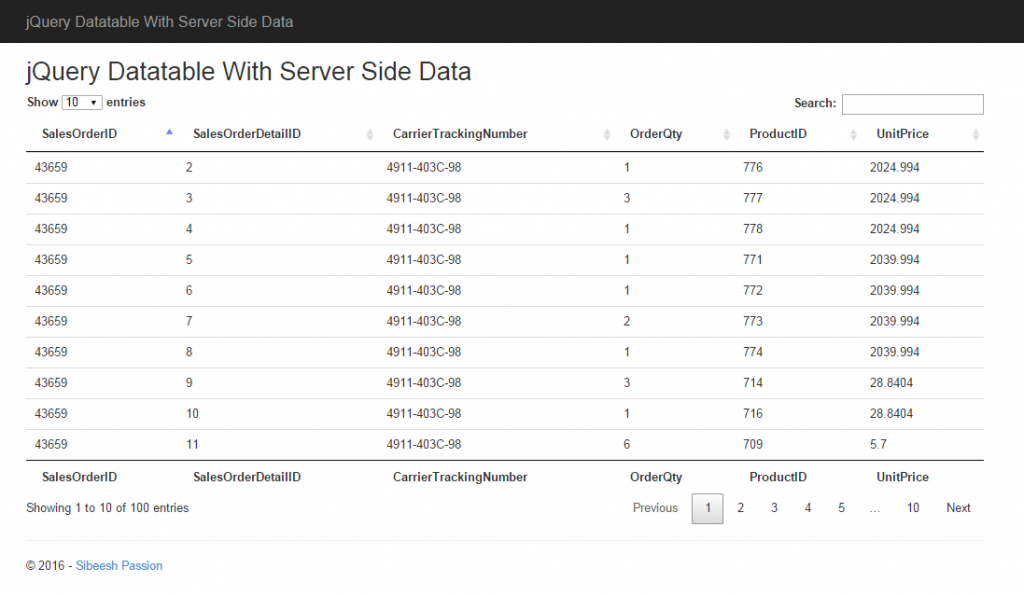
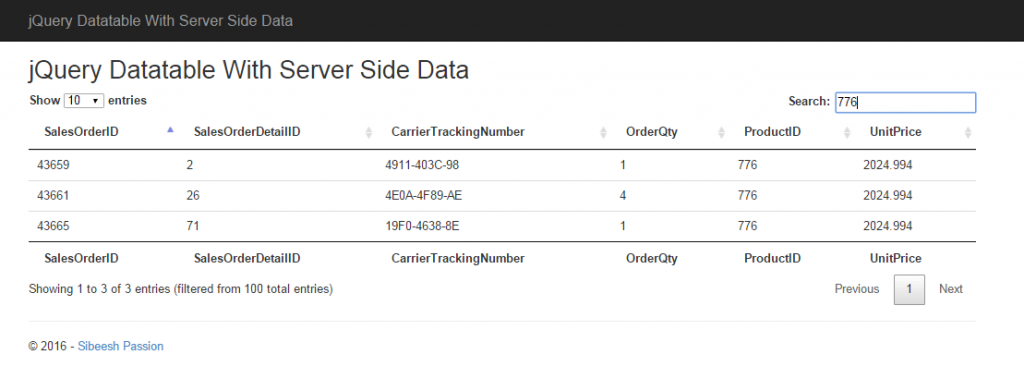
Have a happy coding.
Conclusion
Did I miss anything that you may think which is needed? Did you use jQuery Datatables in your application? Have you ever wanted to do this requirement? Could you find this post as useful? I hope you liked this article. Please share me your valuable suggestions and feedback.
Your turn. What do you think?
A blog isn’t a blog without comments, but do try to stay on topic. If you have a question unrelated to this post, you’re better off posting it on C# Corner, Code Project, Stack Overflow, Asp.Net Forum instead of commenting here. Tweet or email me a link to your question there and I’ll definitely try to help if I can.
Kindest Regards
Sibeesh Venu


